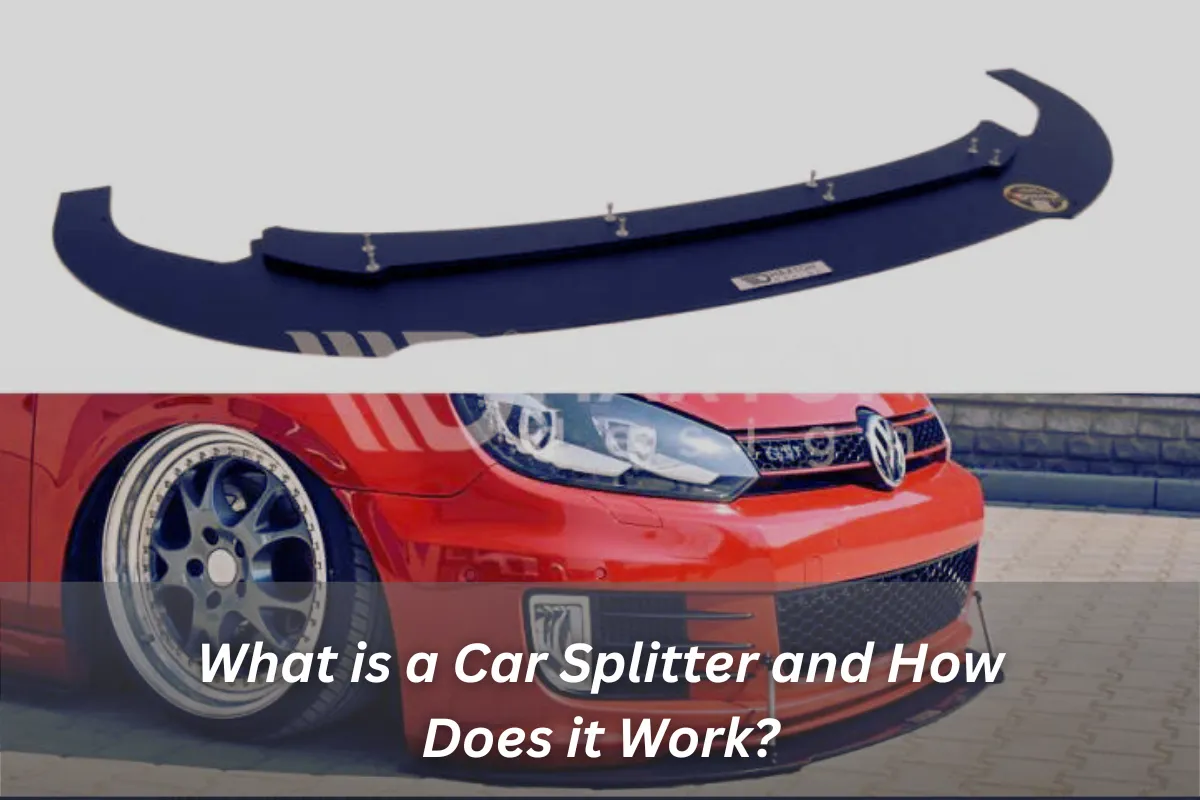Have you ever seen a race car? People who do Formula 1 or other fast-paced motor sports will often point straight to the flat, wide piece in front of the car to show how surprised they are. Splitter: This one is known as a splitter. Though it may not seem important, the splitter is a big part of making the body even faster and smoother! We will talk about what a splitter is used for and how a fixer works in easy terms in this post.
Table of Contents
What is a Car Splitter?
A car splitter is a fixed, horizontal wing that is put on the front of a car to lower its high-speed lift. It sticks out a little past the edge of your car and is usually made of strong but light materials like carbon fiber or glass fiber.

The Purpose of a Splitter
Each splitter is made to help a car cut through the air better. Aerodynamics is the study of how air moves around a moving car. When a car goes faster, it splits up more potential energy in the air. This splitter helps control the flow of air and makes the car run better, especially at higher speeds.
How Does a Splitter Work?
Know About Downforce: Do You Know How A Splitter Works? On the other hand, downforce is a force that pushes a car towards the ground, like in straight line motion. The car stays in place during the race because of the high downforce, which makes the grip better. More grip because the tires are putting more force down on the road, so you can turn bends faster without rolling off.
The Science Behind It
A car can cut through the air because it moves quickly. The pressure drops in front of and around the car because of this. Air moving quickly over the top of the car moves slowly over the bottom. With the height, you can now tell the difference between below and above. That difference between height and speed will make lift: The car might feel like it wants to float or is going really fast and doing strange things. It works the same way as an aeroplane wing: air moves faster over the top of the plane and slower under it. This is what makes a passenger jet fly.
What the Splitter Does
A splitter stops air from going under the car and raises the pressure above it. As the car goes forward, this air comes straight into the splitter. Instead of running under the car like it should (like when you’re sitting still), most of it will hit your car and force its way over or around it. It has less lift, which makes it push down.
More specifically, here’s what happens when air hits the splitter:
- Air is slowed down: The splitter forces the air to slow down before it flows underneath the car. Slower-moving air under the car means there’s less pressure there, helping the car stick to the road better.
- Airflow is redirected: A lot of the air is pushed upward and to the sides. This helps balance the pressure around the car, keeping it stable.
- More downforce is generated: By reducing the pressure underneath the car and keeping higher pressure on top, the car is pressed down onto the road, improving grip and control.
Benefits of a Car Splitter
What’s the point of a splitter, and how does it work? But why would a car, especially a racecar, need something as stupid and stiff as an extra lip strip? This is why it’s important:

1. Better Handling
When a splitter is on a car, it makes the airflow much more stable, which lets it go faster at higher speeds. In turn, this makes the car feel more stable and gives you better control when turning at high speeds. Your car will handle better if it has more grip. It can turn corners faster without slipping. This is very important for race car drivers, because milliseconds can make a big difference.
2. Improved Stability at High Speeds
When you’re going fast, cars can feel “light” or “floaty,” which makes them harder to control. The answer to this puzzle is lift, which is made by air moving quickly. A splitter stops this lift by slowing down the airflow under your car. This makes it easier to stay in control even at high speeds. That’s one reason why splitters are used so often in race car design.
3. More Efficient Aerodynamics
A splitter moves air away from the car’s bottom, which helps it move through the air more smoothly. Because of this, the car can cut through the air more easily than its predecessor, which can both raise its top speed and make it use less gas, though the latter isn’t nearly as important in racing.
Are Splitters Only for Race Cars?
These are usually only found on race cars, but some high-performance cars that are driven on the road also have them. A lot of car fans call the manufacturer’s front lip because they like to praise it for having more killing power and better wind splitting.

Keep in mind, though, that splitters work best at high speeds. When going every day, especially at highway or city speeds, a splitter may not be as useful. A splitter, on the other hand, can be very helpful for people who like to drive fast and on the track.
Types of Splitters
Not all splitters are the same. There are a few different types depending on the car and the type of racing or driving it’s designed for:
- Fixed Splitters: These are built directly into the car’s body and are not adjustable. They are common on race cars and performance vehicles where stability and downforce are a priority.
- Adjustable Splitters: Some high-end cars or custom-built race cars have splitters that can be adjusted. This allows the driver to fine-tune the amount of downforce depending on the type of track or conditions.
- Street-Style Splitters: These are often added to sports cars or modified vehicles. While they might not create as much downforce as racing splitters, they can still improve aerodynamics and give the car a sportier look.
Do Splitters Have Any Downsides?
Like most car parts, splitters come with some trade-offs. Here are a few potential downsides:
- Lower Ground Clearance: Since the splitter sits low to the ground, it can reduce the clearance between the car and the road. This makes it easier for the splitter to get damaged, especially when driving over speed bumps or uneven roads.
- Not Useful at Low Speeds: Splitters are designed to work best at high speeds. So, in normal city driving, you might not notice much of a difference.
- Increased Drag: While splitters improve downforce, they can also increase drag (air resistance). This might slightly reduce top speed in some cases, but for most performance cars, the benefits outweigh the drawbacks.
Conclusion
The car splitter may look like a simple part to someone who isn’t familiar with them, but it is very important for how the car moves at high speeds. A splitter lowers lift and creates downforce, which makes the car more stable when turning tight or moving quickly. Splitters are usually only found on race cars, but they are also used on some limited-production high-performance road and sports types to make them more efficient.
It is always helpful to understand how a splitter works, whether you drive a race car or just like cars in general. This way, you can appreciate that high-tech racing cars are not only fast, but also generally safe and easy to handle.
FAQS
What does a splitter do for your car?
A car splitter helps improve your car’s aerodynamics by creating downforce. This means it pushes the car down toward the road, which increases stability and grip, especially at high speeds. By reducing lift and controlling airflow, a splitter makes the car easier to handle, especially during sharp turns and fast driving.
Can you put a splitter on any car?
Technically, you can install a splitter on almost any car, but the benefits are most noticeable on performance or racing cars that drive at higher speeds. On regular street cars, splitters are often added more for style than for function. However, installing a splitter on a car that isn’t built for high-speed performance may not have much of an effect and could even reduce ground clearance, leading to potential damage on rough roads or over speed bumps.
What are the benefits of a splitter?
The main benefits of a splitter include:
Better handling: It provides more downforce, which improves the car’s grip on the road, especially during fast turns.
Increased stability: By reducing lift at high speeds, the car feels more stable and less “floaty.”
Enhanced aerodynamics: Splitters help direct airflow more efficiently, allowing the car to cut through the air with less resistance.
Why would I need a splitter?
You might need a splitter if you’re involved in racing or regularly drive your car at high speeds, as it can improve stability and handling. A splitter can help you take corners faster and make your car feel more secure at speed. Even if you’re not racing, some people add splitters for the improved aesthetics or for occasional track days where high-speed performance matters.


 Blog
Blog